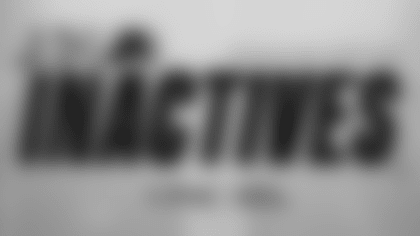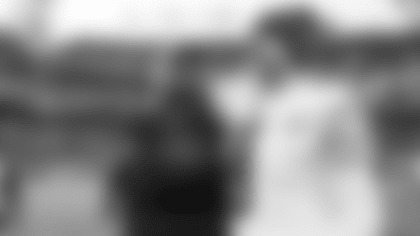Q. Back in the day, it always was the fourth preseason game, or the last preseason game, that acted as the dress rehearsal. Now, it's the third preseason game that's the dress rehearsal. Why did it change?
A. It's changed gradually over time. If something were to happen from a health standpoint in that dress rehearsal, making it that third game gives you more time for that significant player to be ready for the opener. I really think that is the origin of the shift. If something were to happen in that dress rehearsal, now that guy has an additional week or so to be ready for the opener. And they preserve and protect them in week four of the preseason.
Q. Besides the front-line guys playing more, what else about this third preseason game makes it a dress rehearsal?
A. The schematic approach to the preparation. It's not a complete game plan in all three phases, but there is something of a game plan in all three phases, and within that game plan you're looking for things that highlight schematic opportunities relative to the opponent, and you're looking to minimize some warts that you might have. Hopefully you'll see the result of that schematic work, but also it's about the utilization of people, the specialization of talents. To watch people play within personnel groups – you may see Jaylen Samuels come into the first unit in passing situations as a back who's capable of catching the football, for example. Those are some of the things, some of the nuances that make this preseason game more interesting than some of the ones we've played prior to now.
Q. Is there anything in particular about the Tennessee Titans, either in schemes they use or because of some of their individual players, that will make this an attractive matchup for your team in this dress rehearsal?
A. I like quarterback mobility from a preparation standpoint. Marcus Mariota, and even Blaine Gabbert behind him, are very athletic, and very mobile guys. You see it in their schematics, but you also see it in their ad lib. Their ability to buy time and utilize their legs to win possession downs is a significant component of situational ball in this game, so I'm excited that we get that. We get Tyrod Taylor in week one of the regular season, and he's a guy who in a similar way can do damage with his legs. So it's a good preparation game for us on that front. On the other side, we're going against a guy – although he's in a new setting – Dean Pees, their defensive coordinator is very familiar with us as the former defensive coordinator with the Baltimore Ravens. It's good to have that exposure, to be challenged by somebody who knows you intimately the way a division defensive coordinator might. So we're going to be challenged I'm sure on offense from a protection standpoint, and some of our core beliefs should be known to him, moreso than if he was a new guy and hadn't had a lot of exposure to us. To me, those challenges are good for us. Those are the type of challenges we need at this time of the year in terms of team development, and we're going into the stadium to try to win the game in the midst of all that.
Q. After the game in Green Bay, you mentioned that quarterback containment was a problem. Is this what you just were referring to with Mariota?
A. Absolutely. Because quarterback mobility is increasingly becoming a big-time factor in our game, and more specifically in situational football. Teams are not into running their quarterback the way that they are in college, because there's too much risk from a health standpoint. But they are willing to risk it to win possession downs. They are willing to risk it in the tight red zone in an effort to score touchdowns, and you see it all around us. If you look at the AFC North, the mobility of Tyrod Taylor is going to be a factor in how the Browns offense plays out. The drafting of Lamar Jackson in the first round by Baltimore speaks to what their intentions might be situationally, and maybe even in 2018 with Joe Flacco. There's a lot of work to do in preparation for defending quarterback mobility for us.
Q. In your news conference before the game in Green Bay, the word you used to describe Ben Roethlisberger's training camp was "awesome." In particular, what are some of the things that made it "awesome?"
A. Pinpoint accuracy. You can't talk about quarterback play without talking about accuracy. I think that's the single most important attribute. Forget arm strength. It's like a baseball pitcher, if he throws it 100 miles per hour, you know it. If he throws it 90 miles per hour, you know it. But how does he work within that talent. Ben's accuracy has been excellent through this training camp process, and that's the No. 1 thing. The other thing is he came in here in great shape, and he's done a great job actively participating in the growth and development of the younger guys he has to work with, guys like James Washington and JuJu Smith-Schuster and the young tight ends. He's done a really good job in aiding their growth and development. He has checked all the boxes thus far throughout the process.
Q. With two preseason games left, you're still in the evaluation process. How does that work at this stage? Do you establish a pecking order, say, once a week? After each preseason game? Or do you wait until the end and just do it once?
A. You don't do it systematically. If you try to do it systematically or "fairly" you have a lot of headache and you invariably fail. For me, it's about seeing enough of guys in situations so that I know what they're capable of. That may mean a lot of exposure for one guy, and it may mean less exposure for another. What we need is enough information to make a decision. What they need is enough opportunities to show what they're capable of. I'm beyond looking for fairness from a numbers standpoint and micromanaging it in those ways. I want to be able to identify a player and say, "This is his floor. This is what I can consistently expect from him in certain circumstances, or day-to-day. This is his ceiling. This is his upside. This is where I think his play could go." Once I answer those things I need no more visual evidence of where a guy stands. So I focus on this process with that in mind, as opposed to looking at parceling out numbers in a very specific way from an opportunity standpoint.
Q. What are the qualities of a good NFL backup quarterback?
A. He's a guy who can perform to an acceptable level with limited preparation from a physical reps standpoint and that's just the reality of it. Being a backup quarterback in the NFL over the course of a regular work week, you get the reps that the starter does not want or need from a preparations standpoint. So you have to be able to learn from others' physical reps, you have to be able to absorb information third-person, and you have to be able to go out and perform to an acceptable level. That's the baseline element of the job. Sure, you'd like to have a guy who has a tremendous upside who's going to be a future starter and all of those things, but the requirements of the job, the base minimum requirements of the job can best be described as being a guy who can perform to an acceptable level with a minimal number of reps, because that's the reality of the job in the NFL.
Q. Are you satisfied that Landry Jones has those qualities?
A. There's no question. I've seen him do it. I've seen him do it specifically over the last several years. I don't know what Landry's record is as a starter for us over the last several years, but he's a guy who can answer the bell when given the opportunity by the nature of the job, either through injury or by design. We've had a couple of Week 17 opportunities for him, and he's played above the line and delivered and delivered consistently in those settings.
Q. In your mind, what made sense about moving Bud Dupree to right outside linebacker and T.J. Watt to left outside linebacker?
A. Just to highlight certain attributes or skill-sets relative to them. Bud is a tremendous flame-thrower and this gives him an opportunity to match up against some left tackles. T.J. has tremendous awareness, and there's a lot of rhythm passing that goes on on that side of the defense – quick-game and screens and things of that nature. Opportunities to bat passes. They're both interchangeable. They have been interchangeable as young people, and we train our young people that way. We're just looking to settle them down in terms of their partnership, those two guys working together and dividing the labor directionally based on their skill-sets. That's how we choose to do it. But they're not locked in, by any stretch, even by schematics. They change often. They float. We have rover-fronts and things of that nature that demand a different approach. It's going well. We'll continue to look at it and work it, but those guys are interchangeable.
Q. One of the goals of this offseason seems to have been to become more versatile on defense. Why is that important in today's NFL?
A. Just hybrid players and hybrid schematic attacks are unique animals in today's NFL. Tight ends who can function like wide receivers. Tight ends who can function like offensive tackles. Running backs who function like wide receivers in the passing game. Guys like Duke Johnson in Cleveland, a team we play in Week 1, he has unique skills in the passing game. It creates challenges that defenses have to attack, and they attack it by looking for versatile players, players who also are somewhat hybrid. Safety/linebacker-type guys, guys who are able to play closer to the line of scrimmage in sub-package ball, or play in the back end in base. It's also creating hybrid schematics – 3-4 teams become 4-2 hybrids in subpackages, etc. I think the game is about being multiple and being able to meet the needs that the schedule presents. We have 53 guys on our team, and week in and week out we're going to be challenged in different ways, depending upon how our opponent chooses to cut it. Whether that means how they choose to employ personnel, or whether they choose to employ schematics, so you better be multiple to meet the challenges week to week in our business. One week, you might be playing a team that features four wide receivers in a vertical attack. The next week you might be playing a team that features two tight ends and a fullback and they utilize play-action. The people we employ are not going to change week in and week out, and so the people you do business with better be versatile, the schemes you employ better be pliable for those reasons.
Q. So ideally, on defense you'd like to be multiple without having to change personnel?
A. No question. No question, because we have no control over the variables that are presented to us week in and week out. One weekend, we might be presented with a tight end who's an oversized wide receiver and runs a 4.5, and the next weekend we might be presented with a tight end who's a third tackle type, 290 pounds. That's just the nature of our game in terms of the choices the people we play, in terms of how they center their attack.
Q. Is that realistic, to be able to do that with the same group?
A. No question. This is professional football. This is at its highest level. These guys are the best in the world at what they do, and they are the best in the world at what they do for those reasons. You draft guys like Terrell Edmunds in the first round, because his abilities are in line with the ability to do those types of things. He's a very capable coverage guy. He's capable of covering wide receivers. He's comfortable playing in the box. He played subpackage linebacker for Bud Foster at Virginia Tech. That's why you draft these guys in Round 1. This is football at the highest level, and I think that's one of the reasons why we're all fired up about being a part of it and challenged in the ways we are.














